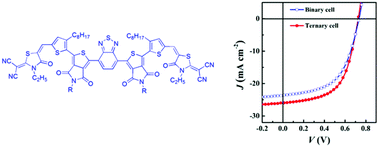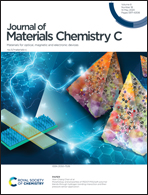Enhanced efficiency and stability of nonfullerene ternary polymer solar cells based on a spontaneously assembled active layer: the role of a high mobility small molecular electron acceptor†
Abstract
It is challenging to afford efficient and stable organic solar cells based on an as-cast active layer without any external treatments. We present a planar organic electron acceptor, BPTCN, with high electron mobility as a third component in nonfullerene ternary polymer solar cells, which comprises an electron-deficient 4,7-bis(5H-4,6-dioxothieno[3,4-c]pyrrol-1-yl)benzo[c][1,2,5]thiadiazole core, doubly endcapped by 2-(3-ethyl-5-methylene-4-oxothiazolidin-2-ylidene)malononitrile through the alkylated thiophene-2,5-ylene unit. It shows a π–π stacking distance of 3.60 Å and μe of 1.31 × 10−3 cm2 V−1 s−1. BPTCN exhibits an absorption maximum at 569 nm in the as-cast film and good miscibility with the NIR-absorption acceptor COi8DFIC, leading to complete förster energy transfer in the blends. Adding BPTCN into the PTB7-Th:COi8DFIC blend produces multiple beneficial effects: (i) facilitating exciton dissociation and charge transfer at the donor/acceptor interface while suppressing bimolecular and trap-assisted recombination, as revealed by analysis of the Jph–Veff, Jsc–Ilight and Voc–Ilight characteristics, (ii) increasing hole and in particular electron transport; and (iii) generally promoting the crystallinity of the polymer donor PTB7-Th, as revealed by grazing incidence X-ray diffraction results. Moreover, the phase purity is greatly improved in the ternary blend PTB7-Th : COi8DFIC : BPTCN (1 : 1.05 : 0.45 by weight). Consequently, the tentatively optimized ternary solar cell provides a PCE of 11.62% with a Voc = 0.74 V, Jsc = 25.93 mA cm−2 and FF = 60.61% in comparison with the binary systems PTB7-Th:COi8DFIC (PCE of 9.41%) and PTB7-Th:BPTCN (6.42%) in the absence of any extra treatments. After thermal aging at 80 °C for 450 h, this ternary solar cell exhibits increased stability with the PCE retaining 84.39% of the initial value.

- This article is part of the themed collection: Editor’s Choice: Organic Photovoltaics


 Please wait while we load your content...
Please wait while we load your content...